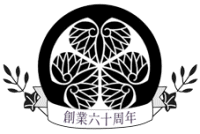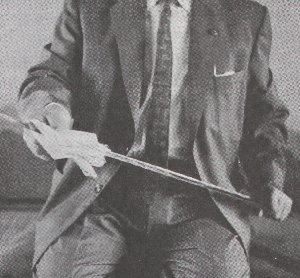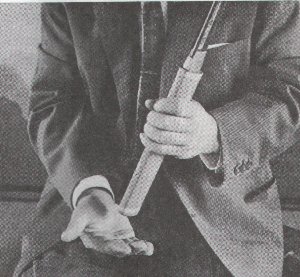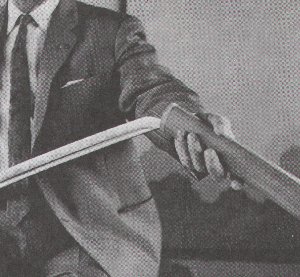How to take care of Swords - 3
| Manual of How to handle and Take Care of Swords_2 | |||
|
10. The reoiling with a piece of paper, or
destarched flannel, folded in size
3cm x
6cm and soaked in fresh oil completes
a round
of swordcare. When the paper is ready,
the
sword is to be drawn out of the scabbard
again. After placing it in the left
hand,
put the oiling paper on the back to
do the
same movement as described in the wiping
process. To make sure the blade surface is throughly covered with oil, repeat the same procedure a few times. Just as the wiping, the handling of the sword as well as the oiling paper must be most carefully done. The paper should contain the right amount of oil so that no excess oil will overflow and harm the scabbard. The oil must be spread thinly and evenly. 11. It is a good idea to apply oil to the surface of the tang with one's fingers. However, an excessive amount of oil must be avoided here. 12. Put the collar back and encase the blade tentatively in the scabbard. Remove the peg from the hilt, draw the blade out of the scabbard, hold it in the right hand in an almost upright position,pick up the hilt with the other hand, and put the tang back in the hilt. Keep holding the blade in the hilt with the left hand and hit the bottom of the hilt lightly with the palm of the right hand so that the tang settles firmly in the hilt. When the tang is fixed in its perfect position, replace the peg. Then, pass the blade to the right hand, pick up the scabbard and slide the blade into ot observing the manner described in Section 2. Needless to say, the other parts like spacers and swordguards of fully mounted swords must also be returned to theirrespective places before the hilt is put on the tang. 13. The method of handling and caring for other forms of blade such as spears8Yari) and halberds(Naginata) are the same. Spears must be handled especially carefully, othewise injury may occur. Also the daggers of double-edged tye(ken) are very dangerous. Swordcare tools must be kept perfectly clean, for dust stuck on the wiping cloth or oiling paper coould cause scratches on the steel surface. Protecting these surfaces which have been most finely polished through the grades processes involving more than ten kinds of whetstones of differernt fineness and hardness is critical. |
||
|
4. How to preserve the Nipponto The most important aspects of preserving blades in any form are to protect them from developing rust and scratches. The precautions requires for keeping the Nipponto in good condition are the following: 1. Despite regular care and oiling, a blade may develop rust in places. Generally when rusting takes place where tje scabbard touches the blade, it must be taken to and repaired by Saya specialist. Or, when the scabbard is very old, its interior may well be contaminated with rust and dirt, thus causing the steel to rust. In such case, a new scabbard must replace the old one at once. 2. Since the formal mounting functions as an outfit for dressing up, a blade needs to have a plain wooden scabbard and hilt which would be, as it were, casual wear for a blade. It is much preferred to rest a blade in its casual outfit so that when the blade surface starts to rust the wooden scabbard can readily be cleaned inside by splitting it open into vertical halves, which are simply fastened together with a paster made from cooked rice. No chemical substances may be used to fasten the parts of the scabbard and hilt. 3. If a blade should start to rust, no inexperienced repairs such as rubbing the rust off with a spatula or coin's edge would improve the condition; rather it is likely to aggravate it and necessitate extra work in smoothing the damaged area. It must be taken to a polishing specialist at once just like a sick person would need to go to see a medical specialist. |
||
|
4. Since a blade is particularly vulnerable
to rusting soon after polishing, cleaning
and oiling should be done preferably
every
ten days for about six monthes. 5. Later when the polished balde surface condition is more stable, clean it regularly, at least every six monthes. 6. In preserving swords, it is improper to keep them in a leaning position because it would cause the oil to go down along the blade surface and make a pool at the point. It is necessary to keep them in a dry place, laid down. It would be ideal to keep them in drawers made of paulownia wood. Use of camhor balls or naphthaline to protect the chest from borers should be avoided. It would cause rust on the steel. 7. Although dry conditions are preferable for swords, the wooden containers or mountings require due moisture. Therefore, the place for preserving swords must be very carefully selected. |
||



